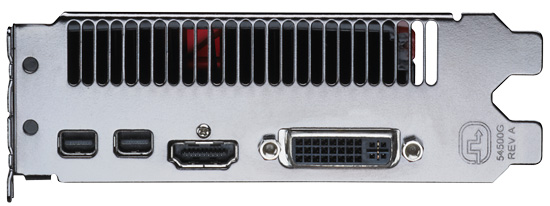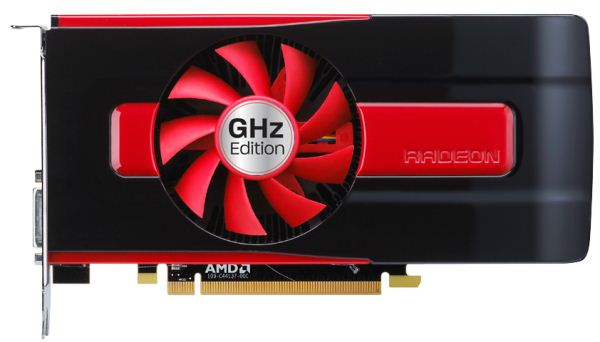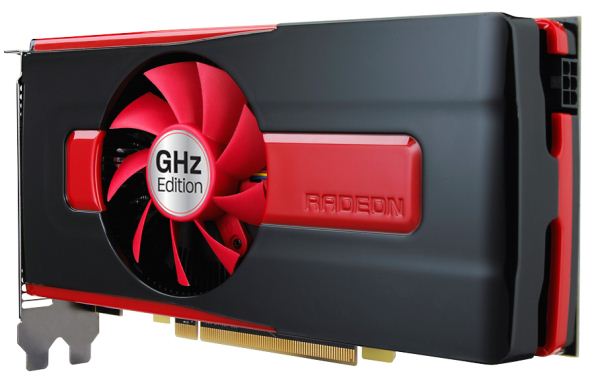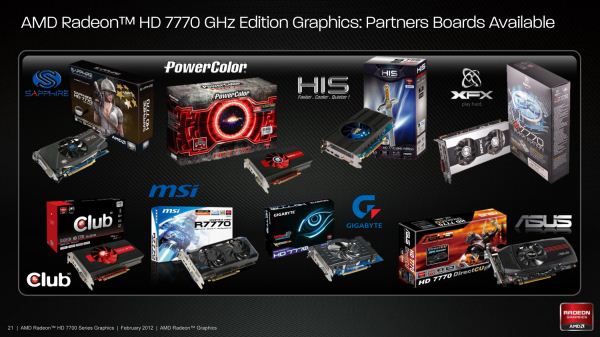AMD Radeon HD 7750 & Radeon HD 7770 GHz Edition Review: Evading The Price/Performance Curve
by Ryan Smith & Ganesh T S on February 15, 2012 12:01 AM EST- Posted in
- GPUs
- AMD
- HTPC
- GCN
- Radeon HD 7000
Meet the Radeon HD 7770 GHz Edition
The second card launching today is the Radeon HD 7770 GHz Edition. Compared to the 7750 it’s based on a fully enabled Cape Verde GPU and features a higher core clock of 1GHz, versus 800MHz on the 7750.
Starting as always with the cooler, for the reference 7770 AMD has gone with something that is best described as half of a blower. The shroud is completely enclosed on the sides, but due to the position of the fan the card exhausts hot air out of both the front and the rear of the card, which is something that’s common for dual-GPU cards such as the 6990 but atypical for a midrange video card. Heat transfer is provided by a basic black aluminum heatsink, while the fan is embedded in the middle of the heatsink.
As for the card itself, it’s effectively an extended version of the 7750. Like the 7750 the card is equipped with 4 256MB 5GHz Hynix GDDR5 RAM chips, along with some additional VRM circuitry to handle the higher 100W power limit for this board. External power is provided by a single 6pin PCIe power socket, while at the top of the card there is a single CrossFire connector. This is actually down from 2 connectors on the 5700 series, which comes as no great surprise as virtually no one ever used tri-CF with the 5700 series in the first place. Overall the card is 8.25” long with no notable shroud overhang, making it the same length as the 5770’s PCB.
Meanwhile for display connectivity AMD is using the same configuration as we’ve seen on the 7900 series: 1 DL-DVI port, 1 HDMI port, and 2 miniDP ports. Unlike the 7900 series AMD’s not requiring their partners to include any adaptors, so buyers with 2 DVI monitors will almost always be on their own. The presence of 2 miniDP ports means that the 7770 has quite a bit of flexibility in driving various displays, however as with the 7900 series if you want to drive more than 4 displays you will need a MST hub, the release of which is still some time off.

As for partner cards, as with the 7750 all of AMD’s partners are doing their own thing. No one will be using AMD’s reference cooler, though PowerColor in particular will be using a cooler similar to it. Everyone else will be using their own double-wide coolers, most of which will be open air as we typically see in this market segment. Like the 7900 series AMD is relying on the 7770 having some degree of overclockability, so there will be a number of factory overclocked cards taking advantage of this.
Finally, I wanted to quickly touch on the naming of the 7770. The official name of the 7770 is the Radeon HD 7770 GHz Edition; with the last bit being AMD’s latest marketing push. Starting with the 7770, AMD is going to be branding every card with a reference clock at or above 1GHz as a “GHz Edition” card to capitalize on the fact that they’ve hit 1GHz. Thus in spite of what the name implies there won’t be a 7770 non-GHz Edition card, as it’s a tagline rather than a true suffix necessary to differentiate cards.
With that said, while hitting 1GHz on a GPU is a notable accomplishment for AMD and should not be ignored, it’s not going to be particularly important in the grand scheme of things. The embarrassingly parallel nature of rendering means that GPU performance isn’t nearly as tied to clockspeeds as CPU performance is, as you can always lay down more functional units to improve performance. Clockspeeds do need to go up over time due to the limited parallelization of the command processor, but otherwise GPU performance has never been heavily dependent on clockspeeds.



















155 Comments
View All Comments
KaDomoT - Wednesday, February 15, 2012 - link
Soemthing went very wrong during your Skyrim testing. I ran a 6870 in a similar rig (X4 955 @ 3.5ghz, 4gb ram, no ssd) @ 1920x1080 with 4x AA / 16x AF and A LOT of texture mods and my fps was MUCH higher than that. Not only that, but this was before the big performance boost in patch 1.4 / before I had even heard of SkyBoost!Admittedly my card was overclocked a good chunk (955 core / small mem oc) and my cpu had 600mhz on yours but no way that accounts for some massive 35+ fps difference especially when you guys have the performance patch and no mods.
takeship - Wednesday, February 15, 2012 - link
I think what everyone is missing here is that neither the 7750 or 7700 is really a card for builders, but for the OEM system builders, local shops, etc. For that segment, these cards are fastastic. Just look at the power and thermal loads - if you're HP, now you know you can sell the end customer a 7750 "HD Video" build for cheap, or a push the upgrade to 7770 based "HD Gaming" system without changing the power supply or cooling! That's huge for those guys. Simplification of the assembly line, part variety, etc etc. Same thing with Dad at home. Kid wants to play Battlefield? Buck at the shop around the corner knows that 7770 will get him there and then some playing on their "old" 1080p monitor without worrying that he'll see them back in 4 months when the system melts.CknSalad - Wednesday, February 15, 2012 - link
I think it's best to wait for kepler. There's really no point to be an early adopter of ati's 28nm cards. I'm sure the price will be fixed as the way it should comparable to nvidia's offerings. I just hope that nvidia is really taking the time to actually make quality gpus that are fairly mature. I wonder when there will be stable, legitimate drivers for ATI's 28nm cards. Hopefully that will give a decent boost in performance.haukionkannel - Wednesday, February 15, 2012 - link
Well this seems to be the trend. Older cards allways seems to better in bang for the buck department.It has been very slow time in GPU selling, so there are a lot of those old 5xx and 6xxx cards, so they have to sell those out before they can recure the prices for these new... Or nobody would buy those older allready produced cards. It is pity to us consumers, but a must to GPU manufacturers.
At this moment there is allmot none reason for AMD to make old 6xxx series cheaper, because the Nvidia is not making enough pressure. So they release new cards at extreme prices and sell those old card first.
Nogib - Wednesday, February 15, 2012 - link
I have been looking for an upgrade for my 4850 512MB card with a similar great bang for the buck that this card has given me all these years. Guess I'm still going to be looking. 7770 is close, but not enough of a leap to be honest. And while I'm sure the 78xx series will be great, I'm guessing it will be at a $250-$299 price range which is far beyond what I would ever consider spending on a video card. Sigh.Mathos - Wednesday, February 15, 2012 - link
You're right about the price/performance thing for a release.But, you also have to take some things into consideration. Some of the performance difference is likely due to the 6800 cards having a 256bit memory bus, as opposed to 128bit. Even with that standing I'm amazed the 7770 gets as close as it does. The main reason the 7770 is more expensive, I'm thinking is more likely so they can cease production on the 6800 series and dump inventory. The 68xx cards have been out for a while, and have benefited from many driver optimizations, but, you're not likely to see any more performance out of them from driver updates than what they already have. The 77xx cards are still based on a new core, which through driver updates will likely get much better performance over time.
Bottom line for me though, is, does it perform better than the 5770 that I currently have. Which, it does so considerably. More than could be said for the 6770. It also makes me wonder if they aren't gonna end up doing a 7790, basically a cut down pitcairn with a 256bit bus, like they did with the 6790.
chizow - Wednesday, February 15, 2012 - link
lol Hi rarson. :)Looks like you almost get it. Don't worry once the 7800 parts launch it'll fill in the blanks for you. The entire 7-series product stack pricing fails, top to bottom.
marc1000 - Wednesday, February 15, 2012 - link
actually the 7850 is the real star here. a board that does not require pci-e power and is able to almost match the 5770 in performance on most of the games. that was a 100w card.in the other hand, this makes me a little worried about the power requirements of 7800 series. i am hoping that both 7850 and 7870 will require only 1 pci-e power plug. my case is not big enough to handle more heat than that, and this is why i dont upgrade to a GTX560 (2x power connectors).
mczak - Thursday, February 16, 2012 - link
I think for the 7850 there is a possibility it would only have 1 power connector.The expectation is that Pitcairn is roughly "2xCape Verde", which means it should have roughly twice the power draw too. Twice the 7750 power draw is easily under 150W, whereas twice the 7770 power draw is not (well close actually according to measurements, but clearly these cards want to allow powertune +20% settings and overclocking).
That would be similar to HD6850/HD6870 where the 6850 only has one pcie power connector but the 6870 has two.
marc1000 - Thursday, February 16, 2012 - link
i meant 7750 is the star here.